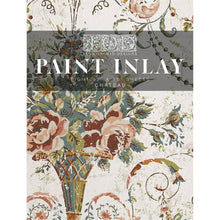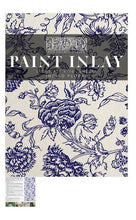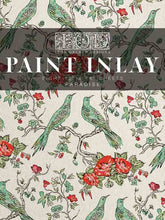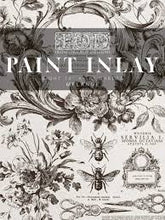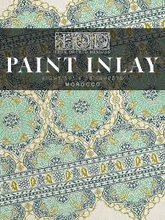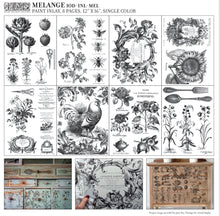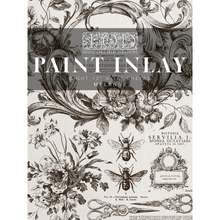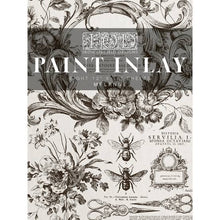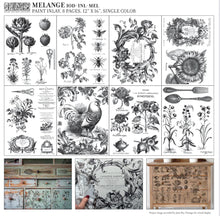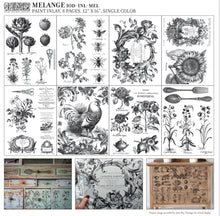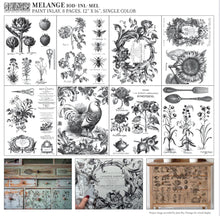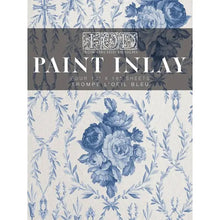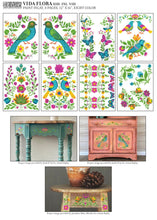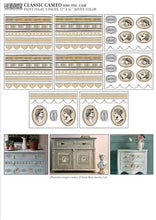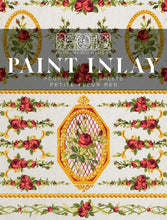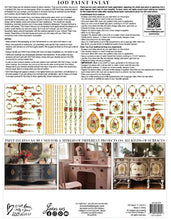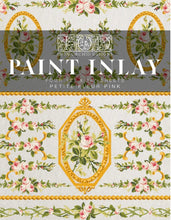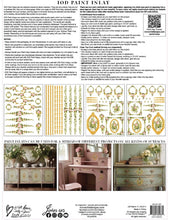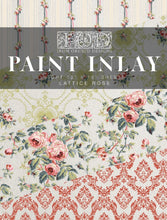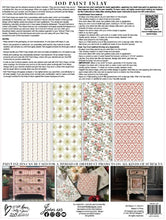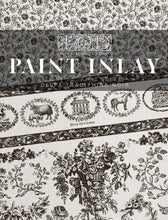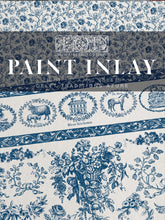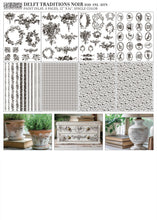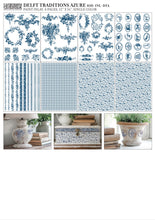
WHAT ARE IOD PAINT INLAYS?
IOD Paint Inlays are ground-breaking, first-in-class, premium art products that will revolutionize the DIY industry and empower creative exploration across all skill levels. In short, they are AH-MAZING, if we do say so ourselves. (Three years in the making so we love them like our kids!)
IOD Paint Inlays are the artisanal answer to decor transfers. They’re not a decal; they’re not a synthetic film; they’re not decoupage.
When you apply an IOD Paint Inlay, paint is physically embedded into the surface of your project. After drying, the carrier paper is removed, leaving an authentic painted design and a buttery, almost leather-like surface on your piece.
HOW DO IOD PAINT INLAYS WORK?
IOD Paint Inlays are made from proprietary artist-quality paints that we formulated specifically for decorative use. Organic in nature, the Paint Inlays transfer the painted design yielding a slightly varied and uniquely beautiful aesthetic each time they’re used.
The results are visually interesting, texturally complex, and often inherently distressed. The paint formula is 'active' until sealed. That means that you can manipulate it and apply special techniques or a custom touch before you seal your piece.
HOW DO I USE IOD PAINT INLAYS?
Basic Steps for Use
Step 1: Plan the layout of your designs for your surface.
Step 2: Using the grids on the backside of the inlay sheet, trim as needed and set aside. If you are using a repeat pattern and lining the pattern up continuously, then trim the excess margin on each sheet.
Step 3: On an appropriately prepared surface, apply a generous and even coat of mineral-based chalk-type paint. Work in small sections to manage the paint-drying window as you work, generally not larger than 12"x16".
Step 4: While the paint is still wet, lay the paint inlay sheet, design side down (grids are printed on the back for easy identification of front and back), into the wet paint, keeping it taut.
Step 5: Spritz lightly with an even mist of water. Using a smooth damp sponge, soft folded cloth, or the small IOD Silicone Paint Blade, pat down with even light pressure to make sure the design makes good contact with the painted surface. Avoid excessive moving or dragging of the Paint Inlay sheet once it is laid down, as this can cause blur or smear.
Step 6: Repeat steps 3-5 to complete your design, lining up your sections as appropriate. The gridlines can help to match pattern edges when needed.
Step 7: Allow the Inlay to dry to the touch. Drying times can vary anywhere from 10 minutes to one hour, depending upon conditions.
Step 8: When ready to remove the Paint Inlay sheets from your surface, spritz evenly with water, and allow 30 seconds to absorb; this helps the backing to release. Starting at one corner, gently pull the paper up, keeping it at a low angle. It should come up easily without tearing. If it does not, spritz a second time and wait a moment, then try again.
Step 9: If desired, you can use water to blend out or soften the design, because the pigment is still movable and active. You can even add additional colors.
Step 10: Once you’re happy with the Paint Inlay design, allow your project to fully dry. Dry time will vary depending on the thickness of the paint coats, how much water was used in the process, the room temperature, and weather conditions. If the surface is cold to the touch, it is not completely dry. To be sure, wait 24 hours.
Step 11: Now, it’s time to seal it.
HOW DO I SEAL AFTER USING AN IOD PAINT INLAY?
There are a few different options for sealing:
- Spray on a water-based sealer of choice using a spray gun designed for paints and finishes.
- Apply a brushed on water-based polyurethane-type sealer directly over your work. This method is likely to result in some pigment migration; this is minimized by avoiding overworking.
- Create a “mistable” setting spray using a 50/50 mix of water and your favorite water-based sealer. Apply with a fine spray mister. Allow it to dry completely and then apply your brushed-on sealer.
- Set your work initially with a commercially available spray-on sealer or artist's fixative. Allow it to dry completely and apply your finish of choice.
- You can also use wax to seal your piece. Apply according to the manufacturer's directions and buff to a sheen as usual.
- Some oil-based finishes can be applied directly by brush to the surface without reactivating. Test in a small area before applying. Note that most oil-based finishes do tend to discolor to amber with time, and that is most noticeable on light colors.
- IMPORTANT NOTE: Always check for compatibility between sealer/finish products when using more than one.
CAN IOD PAINT INLAYS BE USED MORE THAN ONCE?
And, as if once isn't enough, you can usually get a beautifully faded second impression, with the residual pigment on your 'leftover' Paint Inlay sheets. Depending on the techniques and colors you are using with your Paint Inlay, sometimes you can even get a third impression!
IMPORTANT NOTE: For best results with a basic application, use a chalk-type paint that does not contain polymers. (Polymer-based paints and topcoats can also be used, but the timing and results vary, so check out our tutorials for that and more special technique videos coming soon.)
HOW DO I STORE MY IOD PAINT INLAY?
Keep your Paint Inlays stored in the packaging at room temperature, in a dry area, until ready to use. Always handle your Paint Inlay sheets with care and keep them completely dry until ready to use.
After use, lay the sheet on a flat surface, pigment side up, and allow to dry completely. If you saved the protective tissue, use these between the saved inlay sheets.
Then you can put them back in the packaging until you’re ready to use for a second impression.
WHAT ELSE CAN I USE IOD PAINT INLAYS ON?
IOD PAINT INLAYS ON FABRIC
IOD Paint Inlays can be used on fabric with a quality fabric medium and, YES, you can get more than one impression even on fabric!
For this application, we used GAC 900 by Golden (affiliate link).
IMPORTANT NOTE: When using IOD Paint Inlays on fabric, the results will vary dramatically depending on the composition of the fabric, its texture, and the application process. Test on a small fabric sample. Using the Inlays on fabric is not an exact science - experiment and have fun, but keep an open mind!
To use IOD Paint Inlays on fabric WITHOUT painting the fabric first:
Step 1: Dilute the GAC medium to 50/50 GAC/WATER and put it in a spritzer bottle or a dish with a brush.
Step 2: Apply the mixture to your fabric.
Step 3: Apply the mixture to the face of your inlay. This is the side with the painted designs on it.
Step 4: Place the Inlay face down onto the wet fabric. The grid lines will be facing up at this point.
Step 5: Apply pressure using a variety of techniques depending on the look you’re trying to create. This could be rolling the back of the Inlay with a brayer, blunt tapping, covering it with a thin mount and then sliding a blunt object over it to create contact -- or any other creative way come up with. Again, this is a great place to experiment!
Step 6: Allow the fabric and the Inlay to dry (do not remove the Inlay from the fabric yet).
Step 7: Dampen as you would in the instructions for the traditional use of the Inlay and remove the carrier paper.
Step 8: Spritz the paint pattern with diluted GAC (50/50).
Step 9: Allow it to dry and cure for a minimum of 24 hours.
Step 10: Heat set with a dry iron (no moisture or you’ll reactive the paint).
To use IOD Paint Inlays on fabric when you paint the fabric first:
Step 1: Dilute the chalk-type paint to the consistency of cream.
Step 2: Mix a 50/50 ratio of GAC with diluted paint.
Step 3: Apply a coat of the paint/GAC mixture to the fabric with a brush.
Steps 4 through 10 are the same as above (without the painted background).
IMPORTANT NOTE: We always prefer cotton or high cotton blends for textile projects as they generally produce the best results. Different weaves of fabric will have varied results. For example, a soft cotton jersey tends to give a soft blurred effect, whereas a muslin type of weave will give a crisper image.
IOD PAINT INLAYS ON GLASS
IOD Paint Inlays can be used on glass using a clear medium that’s been formulated specifically for glass adhesion.
For this application, we used Dishwasher-Safe Mod Podge (affiliate link).
To use IOD Paint Inlays on Wavy Glass Projects
Step 1: Thoroughly clean the glass.
Step 2: Trim inlay and plan the composition with enough spent carrier paper to cover open areas.
Step 3: Coat the glass where you want to use the Paint Inlay with the clear medium. We used undiluted Dishwasher-Safe Mod Podge.
Step 4: Place the Inlay sheet face down (paint side down) and make good contact by rolling the back of the paper with a brayer.
Step 5: Coat the rest of your glass with the medium and apply a spent (used) carrier sheet. The purpose of this is to create a uniform texture on your glass which means no paint is transferred (that’s why you use a carrier sheet that’s completely spent.)
Step 6: Let all the Inlay sheets dry to the touch.
Step 7: Spritz with your medium and then wait a moment for it to saturate the paper. Carefully remove the Paint Inlay sheets.
Step 8: Allow your piece to dry thoroughly.
Step 9: Seal your project by using a fine mist spray bottle filled with the water/Mod Podge mixture. Allow it to fully dry and then apply a second coat of water-based sealer with a brush.
COMMONLY ASKED QUESTIONS FOR IOD PAINT INLAYS
Q1. Can you seal the Paint Inlays with wax instead of a water-based topcoat?
Yes, you can seal with wax as well, but as always, product ingredients vary by manufacturer, and you should always test in an inconspicuous spot.
Q2. How long can you leave the sheets between applications? Can it be months?
Theoretically (based on ingredients), indefinitely. Just make sure you store them flat and in a dry, low-humidity environment.
Q3. My local stockist doesn’t carry chalk-type paint. Can I use the IOD Paint Inlays with other kinds of paint?
The IOD Paint Inlays were designed to work with chalk and mineral-type paints that do not contain significant amounts of polymer binder.
There is a very important working relationship between the paint and the inlay. The paint needs to release the inlay easily after it has completely dried, and been remoistened. You should not have to put a lot of tension on the inlay carrier to remove it, and certainly not enough to tear it.
The nature of polymer binders (acrylic for example), is to bind well, which makes them work against the inlay process. In our testing and development, this is evidenced by the carrier fibers that are left in the paint finish when used with some polymer-based paints.
HOWEVER, paint ingredients vary greatly by brand, and their performance with inlays varies as well. Generally speaking, some polymer-based furniture paints CAN be used with IOD Paint inlays, with a little extra care in the timing. The same goes for polymer-based clear topcoats.
With chalk and mineral-based paints that do not contain significant amounts of polymers, you have a long drying window (they can sit for days before removal without a problem).
With furniture paints that have significant polymer binders, you will want to check them and remove them as soon as they are dry to touch, maybe even while still cool from dampness. Know that there is also a likelihood that fibers can be left behind, though it’s often not significant enough to see without a loupe.
In our testing, latex paints did not work well with IOD Paint Inlays. Please consult with your local stockist as they can share their experience with the IOD Paint Inlays and their preferred brand of paint.
Q4. You mentioned the Inlay is "active until sealed”. Will the Inlay ever dry if not sealed?
The inlay dries quickly. In fact, you should wait until it’s fully dry before sealing, but it will always be active until sealed. Active meaning, it can be reactivated by water.
Q5. What's triggering the inlay to set when a water-based topcoat is applied? Or is it still active beneath the water-based sealer?
The sealing mechanism is physical more than chemical. There's no catalyst involved. Think of it the way a mineral-type paint is sealed and how that works. There's a combination of two things, penetration of the coating into the porous material and a barrier.
Q6. Why are we waiting for the paint to dry before removing the carrier sheet? Is it to capture/grab the inlay paint?
Yes, in a sense. When the paint dries, the bond between the paint coat and the paint on the inlay is stronger than the bond between the paint inlay and the carrier paper. It basically becomes one with the paint coat. It’s "inlaid" or "embedded.”
Q7. Do the Paint Inlay pads have to remain absolutely flat, or can they be slightly rolled on one end?
We *THINK* they can be rolled without damaging the Inlay. However, we recommend storing them flat as it’s easier to apply them when they’re not curling. Additionally, flat storage keeps the covers of the pad flat for restorage of the dry, used Inlay sheets.
Q8. When considering shipping and storage as with other IOD products, are they affected by heat and or cold? Are they more sensitive or more durable than the transfers?
In typical heat or cold environments, we believe they are more stable than current transfers. However, heavy moisture situations could affect them. Typical environmental humidity would not be a problem as unused/new Inlays are relatively protected by the cellophane wrapper.
Q9. Can we use a water-base topcoat in a spray or aerosol format instead of mixing water with a water-based sealer?
Yes. The dilution technique is just a hack that we like, but only one option. You can absolutely spray a liquid sealer full strength through a sprayer, or use an aerosol option.
Q10. Can we use a dryer to accelerate the drying process?
Yes. However, we prefer the drying mechanism of gentle air movement to heat. We use fans a lot, and because of the nature of the paint, much like mineral-based paint, it dries pretty quickly. We avoid drying tools that get very hot, as heat can compromise the stability of paint in general, and cause bubbling or even delaminating of furniture surfaces.
Q11. If I use this on my walls (painted wood panel), will I need to seal it or can I just leave it to dry with the regular paint?
Yes, you will need to seal it, unless you are going for an ongoing sort of evolving abstract work of art that includes drips and kid smudges and...
Q12. Will this work over mildew-resistant paint?
We don't know about the mildew-resistant paint, but since it's not chalk-type paint and probably is very polymer-based, it would likely work differently and need some fuss. If you want to use a mildew-resistant paint, we recommend you do the following:
- Paint the surface with mildew resistant paint
- Coat the surface with a mineral type paint (over top of the mildew resistant paint)
- Apply the IOD Paint Inlay
- Seal as directed and, perhaps, add an additional coat of sealant for durability
Q13. To avoid repainting a piece, is it possible to use an adhesive like peel stop and lay the paint inlay on that? Or a glaze? Or Modge Podge? Or a water-based sealer? What about Clear Chalkboard paint?
See question #3. You can inlay it into clear topcoats, with special considerations for timing. Different brands of topcoats/sealers and polymer-based paints will be more forgiving with IOD Paint Inlays than others.
For example, some non-chalk-type paints and sealers will grab the heck out of the Inlay carrier sheet and won't let go if allowed to dry. Some will work fine as long as you remove as soon as it’s dry to the touch.
Timing is key when using polymer-based products with IOD Paint Inlays. Consult with your IOD stockist and remember to test in an inconspicuous place.
























